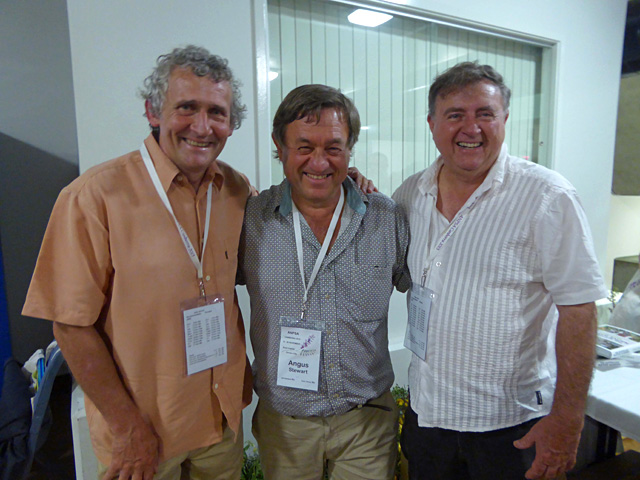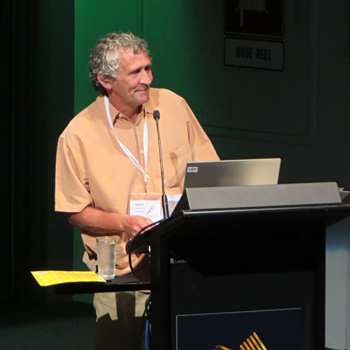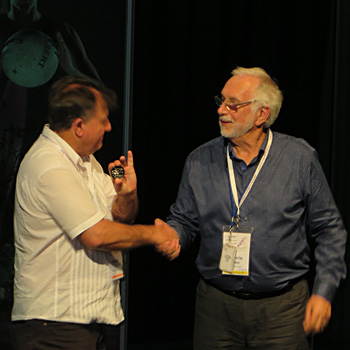Australian Plants Awards 2015
At the 2015 ANPSA Conference in Canberra, Australian Plants Awards were conferred upon John Arnott (Professional award) and Peter Olde (Amateur award). Citations are reproduced below.

John Arnott (left) and Peter Olde (right)
with 2013 Australian Plants Award recipient Angus Stewart
Photo: Lucinda Royston
John Arnott
John Arnott has made an outstanding contribution to the knowledge of Australian plants through his professional career, particularly in the horticultural aspects of zoos and botanic gardens.
John hails from Perth in Scotland and in 1966 when he was four years old, his family migrated to Australia to live in Melbourne. Since 1984 John has gained qualifications in horticulture, parks management and business. He is a member of the executive of Botanic Gardens Australia and New Zealand and life member of Friends of the Zoos and Geelong Botanic Gardens.
 |
|
John Arnott responding to the |
Over the past 30 years, he has been able to practice both his vocation and his passion in the cultivation and display of plants in the public gardens in Melbourne Zoo, Geelong and Wilson Botanic Gardens and Royal Botanic Gardens Cranbourne.
His real passion lies with the display of Australian native flora. His 20 years at the Melbourne Zoo since 1980 involved numerous projects where native plants are the feature and focus of attention. These gardens demonstrate the linkage between wildlife habitat and biodiversity conservation and therefore focus on a range of differing elements of the Australian flora.
In 2000 John joined the team at Geelong Botanic Gardens as Curator/Director to implement the 21st Century Garden project in which native plants are the primary feature. This development is the catalyst for the rejuvenation of these magnificent gardens. A significant collection of rare and threatened species from the region was also established continuing John’s commitment to plant conservation.
For a short time, John worked for the City of Melbourne where he wrote an interpretation plan for the City of Melbourne Parks and Gardens, followed by a short term at Wilson Botanic Park.
In 2008 John was appointed to his dream job, Manager Horticulture at Royal Botanic Gardens Cranbourne where, with his team of horticulturalists, he developed stage two of the Australian Garden to focus on the eastern seaboard of the continent with its rivers, forest, coast vegetation and urban landscapes. The basic premise is to help people to understand, to value and in turn to protect our wonderful native flora as well as the landscapes and ecosystems from which they occur.
In all of his work he has applied this philosophy to demonstrate and promote that . . . . . “Australian native flora is not an alternative, it is something to garden with – to be inspired by. If I can contribute in any meaningful way to this agenda, then I am indeed a fortunate gardener!”
This statement alone makes John a worthy recipient of the Australian Plants Award.
ANPSA President Lawrie Smith AM
Peter Olde
Peter Olde has made an outstanding contribution to the knowledge of Australian plants, in a voluntary capacity during his membership of the Australian Plants Society of NSW for 38 years. He is an Honorary Life Member of the Society.
Peter graduated from the University of Sydney in 1967, followed by two years in the Australian Army Intelligence Corps and a further two as language teacher at Sydney Boys’ High. Then followed 31 years as a self-employed company director. Peter has been an Honorary Research Director of the NSW Herbarium since 1993.
 |
|
Peter Olde receiving his award from |
He joined the APS Sutherland group in 1977 quickly becoming President then serving in that capacity until 1982. He became leader of the Grevillea Study Group in 1980, a position he still holds. Peter has held various executive positions in APS NSW and was elected President 1988-1990. He was appointed an APS NSW Life Member in 1998.
In 2003 he established ‘Silky Oaks’ at Oakdale a private botanical garden that he planned to display native plants to their best potential. This unique garden has since become a regular participant in the Open Gardens Australia program.
As leader of the Grevillea Study Group, Peter ensures that three newsletters are distributed annually and he also completed the three volume Grevillea Book. He has seen and photographed over 90% of the genus in person. His general interest and knowledge of the genus has led to the discovery and naming of many new species. Most of his taxonomic work is concentrated on the Grevillea of New South Wales and Western Australia. He is currently researching the taxonomy of some of the more complex Grevillea species.
Peter’s all-consuming interest in the Proteaceae family, particularly the Grevillea genus, is demonstrated by reference to the numerous scientific and horticultural publications for which he has been responsible. These scientific publications cover most aspects of the Genus extending from taxonomic studies, Western Australian species, Rainforest species, Grevillea at Burrendong, Waratah, Grevillea nectar sugars, Pests and Diseases, and finally to a short history of cultivars and hybrids.
Truly a man with an unparalleled passion for the Grevillea genus! His consistent and continuing dedication to the knowledge and promotion of Australian plants makes Peter a very worthy recipient of the Australian Plants Award.
ANPSA President Lawrie Smith AM
 Australian Native Plants Society (Australia)
Australian Native Plants Society (Australia)